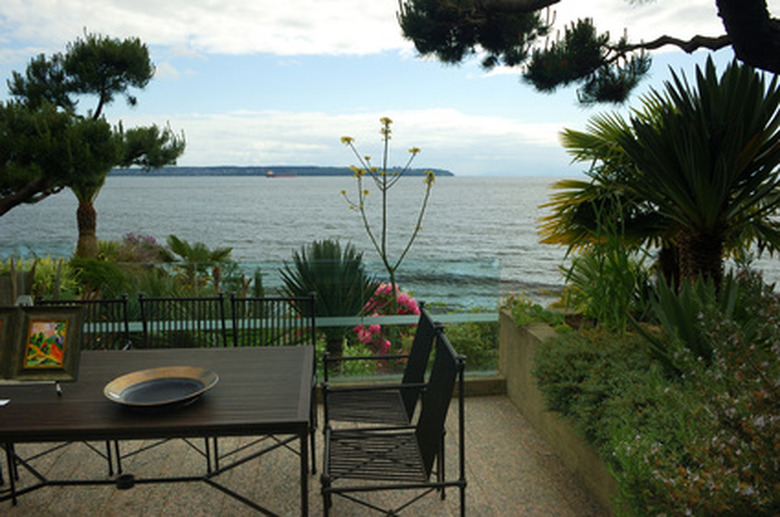Good Shade Trees To Plant Near The Patio
A shade tree can serve as focal point, privacy screen and sunshade on a patio, turning a flat surface into something more than a place to work on your tan. Usually, selecting a shade tree for the patio involves considering both sun and shade, along with several other issues that will make your tree an asset, not a liability. Think in terms of sun-shade balance, privacy or screening needs, and maintenance issues when selecting a tree to grow close to the patio.
Shade and Sun
The question to answer in choosing a tree to plant by the patio is the amount of sun versus the amount of shade wanted on the patio itself. Usually the answer is some of both, which suggests placing a tree 10 to 15 feet from the patio. This way, shade can be obtained without dealing with constant patio-keeping: raking up scattered leaves, dealing with possible seasonal sap-drip, fallen fruit or berries and debris caused by birds and squirrels visiting your tree.
A variety of medium-sized trees combine deciduous branches with relatively short trunks (under 10 feet before branching): amur maple, several varieties of dogwood, non-fruiting peach, pear and plum trees, hawthorne and mimosa. While some patio lovers enjoy the deep and constant shade of evergreens planted nearby, deciduous trees offer deepest shade when summer sun is hot and there's dappled shade in spring and fall.
- A shade tree can serve as focal point, privacy screen and sunshade on a patio, turning a flat surface into something more than a place to work on your tan.
- Usually, selecting a shade tree for the patio involves considering both sun and shade, along with several other issues that will make your tree an asset, not a liability.
Privacy and Screening Issues
For serious privacy and screening issues, you will probably want to explore hedging, trellising or fencing. A patio tree can, however, enhance a sense of privacy into two ways. First, the tree's shade and shape suggest a focal point and perhaps a gathering area on the patio, making the patio seem more settled than perched in the expanse of the yard.
Second, a tree gives those looking from outside toward your patio something to look at besides you, your guests and your activities. Good patio trees, therefore, are characterized by seasonal interest: a flowering tree such as a dogwood offers spring flowers, summer greenery, and often a bronzy or red cast to fall leaves.
Watching a Japanese maple go through its annual growth cycle means gradual color changes with a spectacular fall ending. The dappled shade of a golden-chain tree gives way to clusters of yellow flowers and ends with interestingly textured seed pods. Look for a tree with several seasons of interest to enhance the centered quality and focus of your patio space.
- For serious privacy and screening issues, you will probably want to explore hedging, trellising or fencing.
- Good patio trees, therefore, are characterized by seasonal interest: a flowering tree such as a dogwood offers spring flowers, summer greenery, and often a bronzy or red cast to fall leaves.
Maintenance Issues
A good patio tree is relatively low-maintenance. Avoid, for examples, trees that possess shallow or far-wandering roots when choosing a patio tree. Shallow roots can bulge, damaging patio surface, as trees like larger maples struggle to establish their comfort zone. Willow roots can crack patios in their ever-wider search for water sources. A tree advertised as a rapid grower may give you the "look" you want within a couple of years of planting, but it may come at the price of serious, damaging overgrowth on its way to maturity.
Further Maintenance Issues
As with any long-term relationship, ask lots of questions when choosing a tree to plant close to the patio. Ultimate size is the first question, but there are others. Branch spread, and the height at which branches spread, may have an impact on your choice.
- A good patio tree is relatively low-maintenance.
- Shallow roots can bulge, damaging patio surface, as trees like larger maples struggle to establish their comfort zone.
Fruiting is another concern; it may sound charming to sit under one's own apple tree, but the need for a second variety for pollination, the increase in bees and other insects, a possible need for spraying, and rotting windfalls strongly suggest moving the orchard phase of your garden to another location. (Staining can also be a concern with fruiting trees, as any mulberry or wild-cherry owner will tell you.) Lots of trees can enhance your patio; asking questions about care when you choose a tree will give you more time to enjoy it than maintain it.
